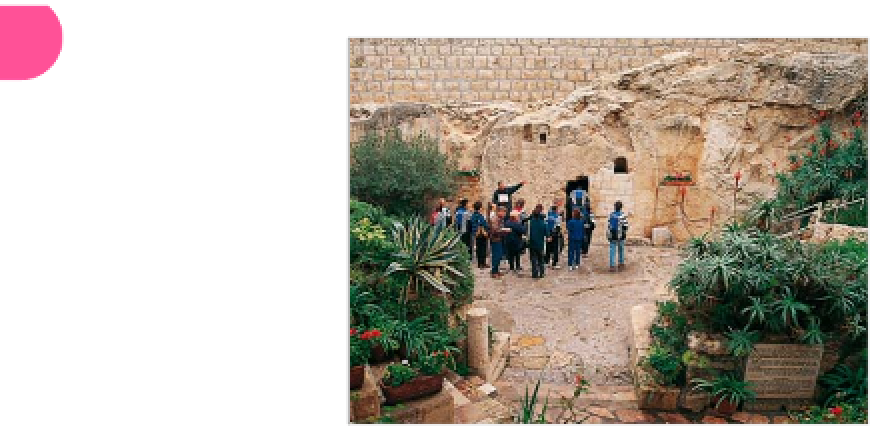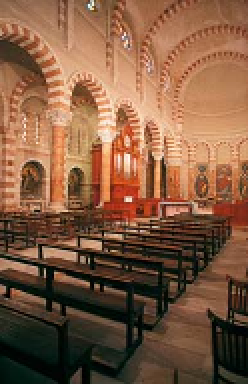Travel Reference
In-Depth Information
Solomon's
Quarries
w
Sultan Suleyman St.
Map
4 D1
.
@
23, 27.
#
9am-4pm Sun-Thu,
9am-2pm Fri.
&
This is an enormous empty
cave stretching under the Old
City, with its entrance at the
foot of the wall between
Damascus and Herod's gates.
Despite the popular name, his-
torians are not convinced that
the cave has any connection
with Solomon, but it is likely
that Herod took stone from
here for his many building
projects, including his modi-
fication of the Second Temple.
The quarry is also known
as Zedekiah's cave, after the
last king of Judaea who,
legend has it, hid here during
the Babylonian conquest of
Jerusalem in 586 BC.
Tourists visiting the ancient Garden Tomb in its attractive setting
St George's
Cathedral
t
53 Nablus Rd.
Map
1 C1.
Tel
(02)
(see pp92-5)
. Excavations
carried out in 1883 did in fact
unearth some ancient tombs,
but further study found them
to date back to the 9th-7th
century BC, with an entirely
different configuration from
those in use in Christ's time.
However, regardless of its
authenticity, this place is
well worth a visit if only for
the lovely garden.
l
628 3261.
@
6, 23, 27.
#
not
generally open for visitors so call first.
Garden Tomb
e
Conrad Schick St.
Map
3 C1
.
Tel
(02) 627 2745.
This Archetypal Middle
England church, with its
pretty, cloistered courtyard and
connotations of vicars, tweeds
and cucumber sandwiches,
stands in startling contrast to
the chaotic Arab streets of its
East Jerusalem neighbourhood.
The cathedral dates from
1910 and is named for the
patron saint of England, who
was actually a Palestinian
conscript in the Roman army,
executed in AD 303 for tearing
up a copy of the emperor
Diocletian's decree forbidding
Christianity. He is supposedly
buried at Lod (ancient Lydda),
now better known as the site
of Ben Gurion airport.
In World War I the cathedral
was the local headquarters of
the Turkish army, and the
1917 truce sanctioning British
presence in Palestine was
signed in the bishop's quarters.
@
1, 3.
#
2-5:30pm Mon-Thu.
www
.
gardentomb.com
St Etienne
Monastery
r
Nablus Rd.
Map
1 C2.
Tel
(02) 626
l
4468.
@
23, 27.
#
open all day;
ring the bell.
Towards the end of the 19th
century the British general,
Charles Gordon, of Khartoum
fame, was visiting Jerusalem
and started a dispute among
archaeologists. He argued that
this skull-shaped hill was the
Golgotha referred to in the
New Testament (Mark 15: 22)
and that the real burial site
of Jesus Christ was here and
not at the Holy Sepulchre
The name of this site relates
to the belief that in AD 439
Cyril of Alexandria interred
the remains of St Stephen (St
Etienne in French), the first
Christian martyr, in a basilica
built on this spot. The basilica
was destroyed by the Persians
in AD 614, and a subsequent
7th-century chapel on the
same site was also destroyed,
this time by the Crusaders
holding Jerusalem, who feared
Saladin would use it as a base
for assaults on the city.
The present monastery was
built between 1891 and 1901
by the French Dominicans. Its
eclectic design includes an
Oriental tower, Romanesque
walls and Neo-Gothic flying
buttresses. Within are remains
of the mosaic floor of the
original Byzantine church,
as well as the Ecole Biblique,
the Holy Land's first school
of biblical archaeology.
The simple Neo-Romanesque chapel
at St Etienne Monastery
St George's Cathedral, part of
Jerusalem's colonial heritage
For hotels and restaurants in this area see pp257-8 and pp272-4















